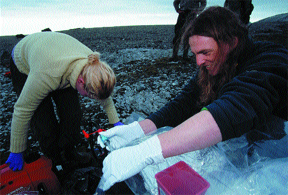 Now that the two rovers currently on Mars have revealed that the planet was
at times far wetter and warmer than it is now, scientists are more optimistic
than ever that they will find life somewhere on the planet — and they will
be looking for it with a host of borrowed technologies. "Science pathways
are responsive to discovery," says James Garvin, chief scientist at NASA.
"The next Mars missions will be astrobiocentric."
Now that the two rovers currently on Mars have revealed that the planet was
at times far wetter and warmer than it is now, scientists are more optimistic
than ever that they will find life somewhere on the planet — and they will
be looking for it with a host of borrowed technologies. "Science pathways
are responsive to discovery," says James Garvin, chief scientist at NASA.
"The next Mars missions will be astrobiocentric."Last summer, a team of scientists traveled to the Norwegian isle of Svalbard, which has an arctic terrain analogous to Mars’, to test a suite of borrowed technologies for looking for life on the Red Planet. Photo by Kjell Ove Storvik.
To that effort last summer, Hans Amundsen of the University of Oslo and Andrew Steele of the Carnegie Institution of Washington led a team of scientists to the rugged Norwegian isle of Svalbard, which has an arctic terrain perfect for testing technologies to detect life on Mars. The region is replete with hot springs, volcanic activity and carbonate rosettes — tiny concentric spheroids with distinctive alternating black and white layered rims — that resemble those found on the martian meteorite ALH840001.
Steele's research team has been devising a sampling and analysis protocol for future Mars exploration. On this expedition, the group planned to field-test four instruments to see how accurately and rapidly they could pick up and characterize subtle signs of life in the martian analog environment. Each device applied a life-detection technology produced not by astrobiologists but by biomedical and environmental science researchers. Steele's team hoped that these diverse technologies would deliver a coherent characterization of the organisms in each sample.
 Although the field data is still
being confirmed in the Carnegie laboratories, the instruments certainly showed
promise, Steele says. "We successfully tested an integrated Mars life-detection
strategy for the first time, and showed that if life on Mars resembles life
on Earth at all, we'll be able to find even a single cell," he says.
Although the field data is still
being confirmed in the Carnegie laboratories, the instruments certainly showed
promise, Steele says. "We successfully tested an integrated Mars life-detection
strategy for the first time, and showed that if life on Mars resembles life
on Earth at all, we'll be able to find even a single cell," he says.Researcher Andrew Steele of the Carnegie Institution of Washington takes samples on the Norwegian isle of Svalbard for testing technologies to detect life on Mars. Photo by Kjell Ove Storvik.
That none of the tested instruments were designed explicitly for extraterrestrial exploration highlights how astrobiologists are looking outside their field of study for technology they can adapt to their own purposes. Although this partly reflects the interdisciplinary nature of astrobiology, it also represents a slight shift away from how NASA has obtained technology in the past.
"We have always acquired technology from outside; all funding is publicly competed," says Greg Bearman, a physicist at the NASA Jet Propulsion Laboratory in Pasadena, Calif. But the last decade has seen remarkable advances in biomedical and counter-bioterrorism technology by organizations that are unfamiliar with NASA, he says — and they may have exactly what NASA needs for its planetary rovers' new brand of robotic exploration. "We believe there are other people out there who have technologies that are applicable to us and we don't know about it. NASA does not want to spend time developing technology that already exists," Bearman says.
Some bioterrorism-prevention technologies, for example, distinguish minute quantities of pathogenic organisms released into the air and water, such as smallpox virus discharged in an airplane, Bearman says. Likewise, astrobiologists search for a few scarce signs of life in extraterrestrial environments. "On Mars no one expects that if they find anything, there will be a lot of it," he says.
One example of counter-bioterrorism research at the Lawrence Livermore National Laboratory in California shows how such technologies may prove fruitful for astrobiologists. Scientists there are synthesizing small molecules that bind to bacterial or viral pathogens by detecting unique protein signatures on the surface of the organisms. Astrobiologists may one day be able to use similar molecular techniques to detect protein signatures of extraterrestrial organisms.
The tricky part of using such ultrasensitive technologies in the search for extraterrestrial life is engineering them to withstand the assaults of intense heat and cold, radiation, wind, and perhaps blowing sand or ice that they will likely encounter on other planets. Bearman says that adapting even the most basic instruments to function in such extreme environments is not as simple as it might seem. "Scientists want to be able to do remotely what they do in the laboratory," he says. "But you have to get the instrumentation in the right package. We spent $1.5 million and a year and a half just making a rock crusher that could operate at martian temperatures and pressures."
To address these unique challenges, Bearman, Steele and Bruce Jakosky, a geology professor at the University of Colorado, Boulder, established the Astrobiotechnology Focus Group as part of NASA's Astrobiology Institute. The group plans to identify the technology needs of the NASA missions that will follow the 2009 Mars Science Laboratory mission, hoping to bridge the technology gaps with instruments adapted from Earth-based science.
Last September, the group held its first event, the Mars Astrobiology Science and Technology Workshop, at the Carnegie Institution in Washington, D.C. The group leaders publicized the event outside of NASA's stable of mostly academic contractors to attract a broader contingent of participants. They drew in about 110 representatives from about 80 academic, corporate, government and private research organizations from the United States and abroad.
Bearman says that he is pleased with the diversity of the attendees because it may be the people who know the least about astrobiology that astrobiologists need the most. "Everyone works in what they do," he says. "The only way you find out about [other fields] is to make a conscious effort."
Up on Mars, the twin rovers continue to operate well past the 90 martian days they were originally designed for. They have been on the Red Planet for almost a year now, sending back amazing images and data (see story, this issue). Scientists hope that the next robotic mission to Mars will be just as successful and that it will reveal new astrobiological information about the planet. "We don't want to miss what Mars is trying to tell us," Garvin says.

